Disclosure: This post may contain affiliate links. I may earn a small commission for my endorsement, recommendation, testimonial, and/or link to any products or services from this website.
Light, fluffy, and moist, this sweet cornbread is made from scratch with simple ingredients that you probably already have in your kitchen. Stir together the batter in just 10 minutes for a homemade cornbread recipe that tastes way better than a box of Jiffy mix! From chili and bbq, to roasted chicken, gumbo, and fried fish, the tasty side dish will soon become a staple on your family’s table.
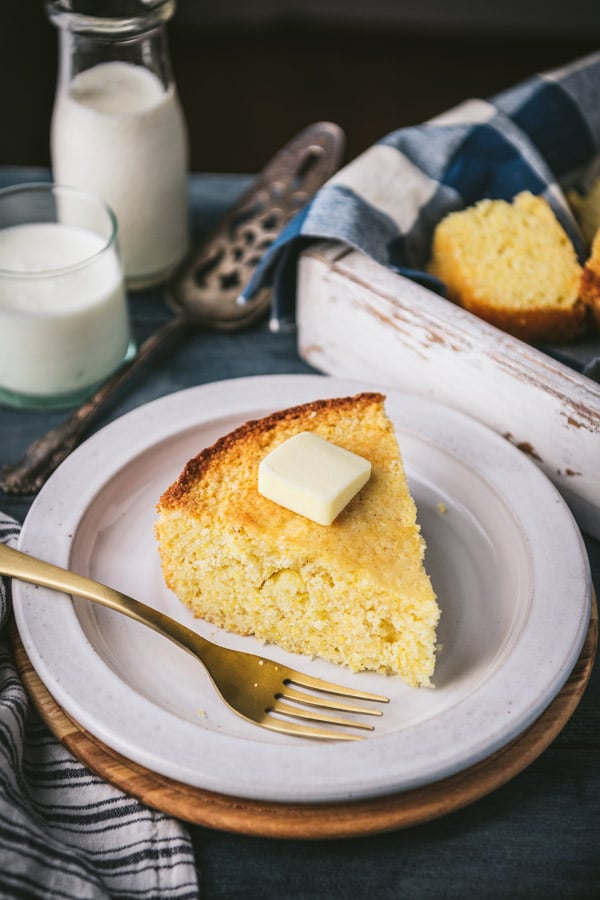
Homemade Cornbread
You know those boxes of soft cornbread mix sold by Jiffy and Krusteaz? Well, I’ve finally figured out how to make a better pan of sweet cornbread at home with just a handful of pantry staples and only 10 minutes of prep. This kid-favorite recipe is sweeter, fluffier, and more cake-like than most homemade cornbread, and it pairs so nicely with savory dinner entrees. You might even like it for breakfasts or desserts, too!
Cornbread has always been one of my absolute favorite foods, so it makes an appearance on our family’s table at least once a week. I’ve tried countless varieties over the years, and I’m always looking for new recipes to test in my own kitchen. This particular sweet cornbread recipe comes from a new-to-me cookbook called The No-Fuss Family Cookbook by chef Ryan Scott. He recommends serving the cake-like side dish with plenty of soft, spreadable, whipped honey butter — and I couldn’t agree more. It’s such a treat!
What is cornbread?
Cornbread refers to any quick bread containing cornmeal, usually leavened by baking powder. Cornmeal is dried and ground corn, and can be found in the baking aisle of grocery stores. This simple, inexpensive bread originated with the Native Americans, who had been using ground corn (maize) for thousands of years.
European settlers in the Southern colonies learned the original recipes and processes for corn dishes from the Cherokee, Chickasaw, Choctaw, and Creek, and soon created their own recipes for using cornmeal in breads similar to those that were familiar in Europe (source). Cornbread has been called a “cornerstone” of Southern cuisine, and sweet cornbread — which has far more sugar than a more traditional (often unsweetened) cornbread — is always a family favorite.
This homemade cornbread has a more moist, tender, fluffy, cake-like texture than other old-fashioned cornbread recipes, and reminds me of the baskets of indulgent, sweet bread that you’ll often find in restaurants and bakeries. It’s still slightly crumbly (as all cornbread should be), but it’s definitely not dry.
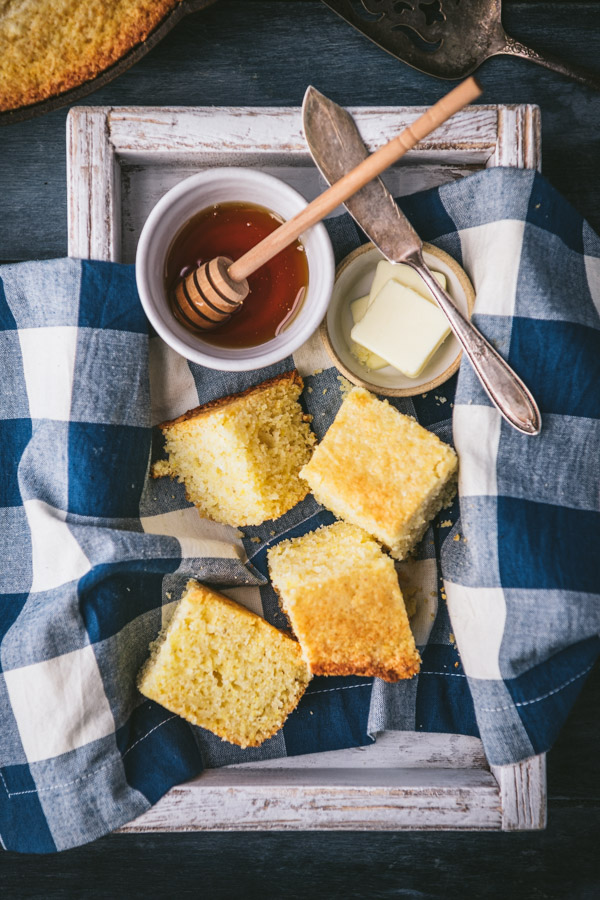
How to Make Sweet Cornbread Moist
Unlike some cornbread that can be crumbly and dry, this sweet cornbread stays nice and moist for a few reasons:
- The oil adds fat and moisture, while the buttermilk or whole milk also keeps the muffins incredibly moist and tender.
- Instead of a more traditional 1:1 ratio of cornmeal to flour, this recipe calls for slightly more all-purpose flour than cornmeal — giving the bread a softer, lighter texture.
- Another trick for moist cornbread? Don’t over-mix the batter. Fold together the ingredients just until everything is combined, and then stop stirring. Over-mixing will yield dry, tough baked goods.
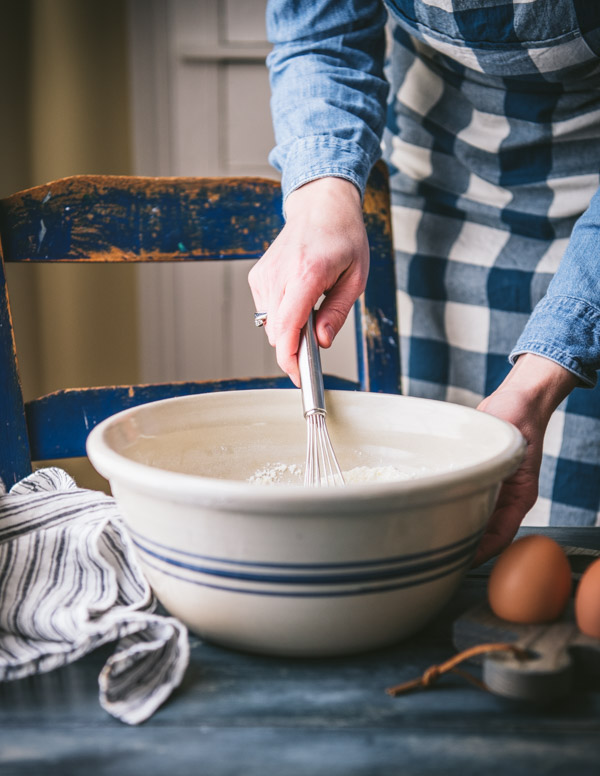
Ingredients
Here’s a quick overview of the basic pantry staples that you’ll need for a pan of sweet cornbread. As always, specific measurements and complete cooking instructions are included in the printable recipe at the bottom of the post.
- All-purpose flour: more flour than cornmeal gives the muffins a lighter texture.
- Plain cornmeal: I prefer finely-ground yellow cornmeal, since it yields a softer texture. You can also use fine white cornmeal if that’s what’s available.
- Sugar: gives this “sweet cornbread” its name! You can reduce to ¾ cup or ½ cup for a less-sweet bread.
- Baking powder: the leavening agent that helps the cornbread rise.
- Kosher salt: to balance the sweetness.
- Eggs: for structure.
- Whole milk or whole buttermilk: I use whole buttermilk, which adds moisture to the bread, creates a soft, tender crumb, and provides a slightly tangy flavor and richness. If you don’t have buttermilk, you can substitute with regular whole milk or cream.
- Vegetable oil: keeps the cornbread super moist.
- Butter: to grease the skillet (or baking dish). I like salted butter, but any variety will work.
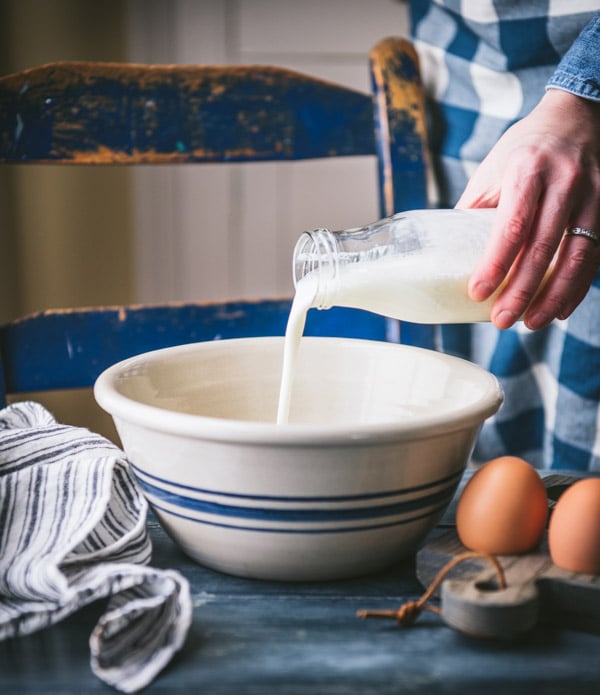
Which Pan to Use
I prefer baking the sweet cornbread in a cast iron skillet, which provides the best crispy edges. If you don’t have a deep 10-inch skillet, you can also use a deep 9-inch baking dish or an 11 x 7-inch dish. Just make sure that your pan is deep, because this cornbread tends to puff up and rise pretty high (especially if you use buttermilk), and you don’t want it to overflow in the oven. Just trust me on this one…
Cast Iron Skillet Cornbread
Baking cornbread in a preheated cast iron skillet creates extra-crispy edges. You’ll need a very deep 10-inch cast iron skillet for this recipe (at least 2 inches deep). Place the skillet with the butter in the 325°F oven for a few minutes. When the butter melts and the skillet is hot, use a pastry brush to coat the butter all over the skillet. Pour the cornbread batter into the hot, greased skillet. Bake for about 40 minutes, or until golden brown and a toothpick comes out clean.
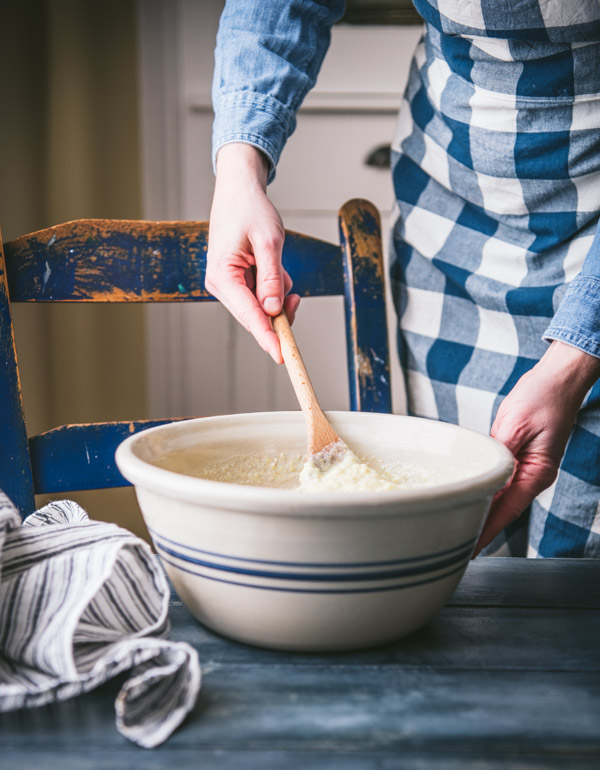
How to Make Cornbread
While a classic Southern cornbread is typically not very sweet (and may not contain any sugar at all), my family always loves the bakery-style sweet cornbread that you find in restaurants and in a box of Jiffy cornbread mix. That’s why this made-from-scratch version is such a hit. The sweet cornbread is a fun twist on the classic, and pairs beautifully with savory dishes. It’s like eating cake with dinner, and it only requires about 10 minutes of prep time!
- Whisk together the dry ingredients in a large bowl.
- Whisk together the wet ingredients in a separate medium bowl.
- Pour the wet ingredients into the dry ingredients. Stir with a wooden spoon just until combined, being careful not to over-mix.
- Transfer the batter to a hot skillet that’s greased with melted butter.
- Bake in a 325°F oven for 40-45 minutes, until a toothpick inserted in the center comes out clean.
- Let cool for about 15 minutes (or more) before slicing and serving.
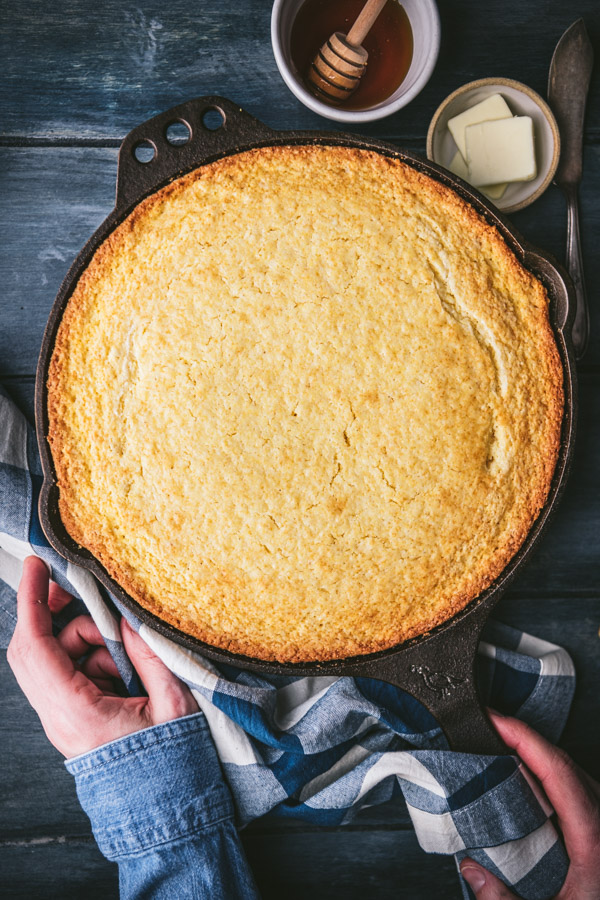
What to Eat with Cornbread
Cornbread is a staple in our house at just about any meal — breakfast, lunch, or dinner. It even makes a nice snack with a cup of coffee or tea! Spread the warm cornbread with butter or homemade honey butter, add a drizzle of honey, or top with a dollop of homemade blueberry jam, strawberry jam, or apple butter. As a side dish, the cornbread goes well with any of these dinner entrées:
- Chili (like this Slow Cooker Chili, Classic Beef Chili, Slow Cooker White Chicken Chili, White Bean Chicken Chili, Texas Chili, or Pumpkin Chili)
- Soup (such as Ham and Bean Soup, Beef Barley Soup, Crock Pot Potato Soup, Split Pea Soup with Ham, Chicken Noodle Soup, Pumpkin Soup, Chicken Vegetable Soup, Hamburger Soup, or Creamy Cauliflower Soup)
- Stew (like this Virginia Brunswick Stew, Crock Pot Chicken Stew, Irish Stew, Frogmore Stew, or Dutch Oven Beef Stew)
- Beans (such as Black-Eyed Peas, Homemade Baked Beans with Bacon, Southern Lima Beans with Ham, Ranch Style Beans, or Cowboy Baked Beans)
- Barbecue (like these Crock Pot Ribs, Pulled BBQ Chicken, Dutch Oven Beef BBQ, or Pulled Pork)
- Seafood (such as Shrimp and Grits, Crab Cakes, and Shrimp Creole)
- Fried Favorites (such as Fried Chicken, Fried Catfish, Oven-Fried Fish, Fried Oysters, or Fried Shrimp)
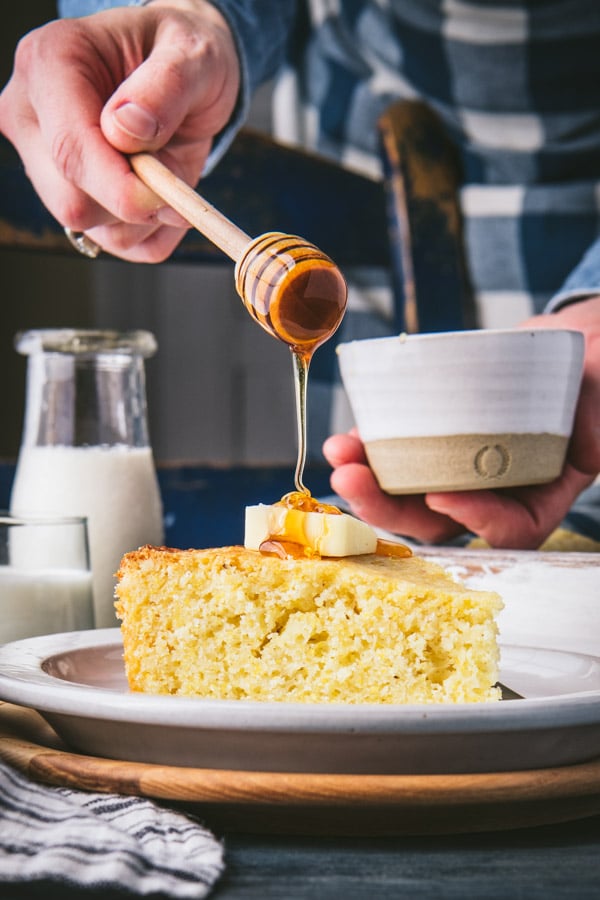
Storage
Cornbread is best when freshly baked and warm from the oven, but you can bake it up to 8 hours in advance and leave it on your countertop until ready to serve. To extend the life of your homemade cornbread, store in an airtight container at room temperature for 1-2 days or in the fridge for up to 1 week.
How to Freeze
Wrapped tightly, you can store cornbread in the freezer for up to 3 months. Thaw on your countertop or in the refrigerator before enjoying.
How to Reheat
To reheat leftover cornbread, wrap in foil and warm in a 325°F oven for about 10 minutes. You can also microwave individual slices of cornbread just until warmed through — about 20-30 seconds.
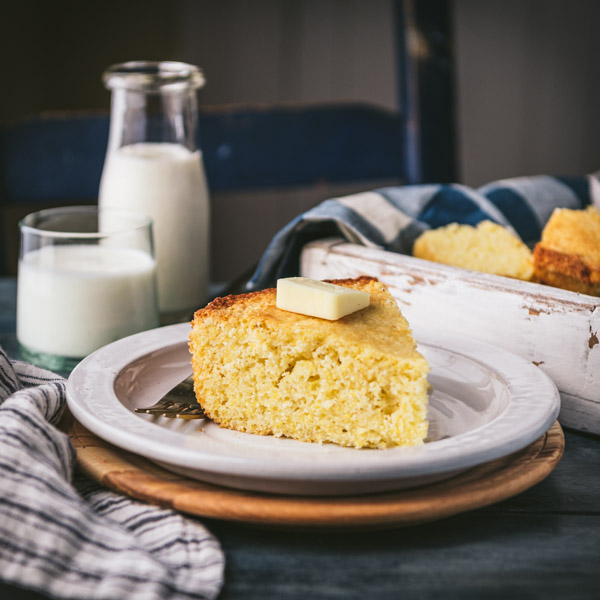
Sweet Cornbread Recipe Variations
- As the name suggests, this is a very sweet cornbread that tastes almost like cake (similar to a box of Jiffy mix or Krusteaz mix). If you prefer your cornbread less sweet, reduce the sugar to to ¾ cup or ½ cup.
- Buttermilk gives the cornbread an even more moist and tender crumb; however, you can substitute with regular milk or cream if that’s what you have on hand. Unlike baking soda, you don’t need the acidic buttermilk to activate the baking powder.
- Optional add-ins: 1-2 chopped jalapeño peppers, 1 cup fresh blueberries, 1 cup shredded cheddar or Pepper Jack cheese, or orange zest and dried cranberries.
- Sweet Cornbread Muffins: Divide the batter between 11-12 paper-lined muffin cups. Bake in a 350°F oven for 18-20 minutes.
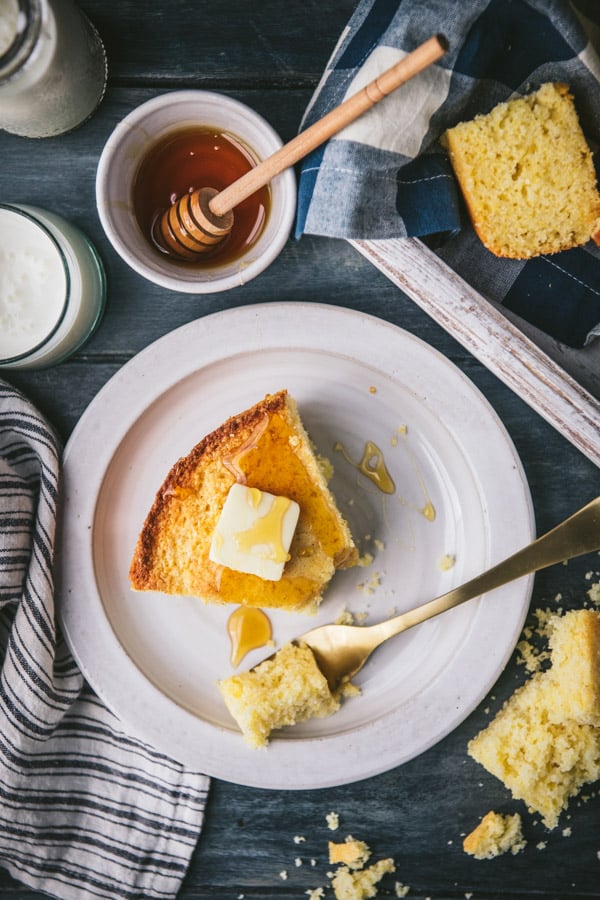
Tips for the Best Cornbread Recipe
- Use a very deep 10-inch skillet (at least 2 inches in depth), or another 2-3 quart baking dish (such as a deep 9-inch square dish or an 11 x 7-inch dish). The cornbread rises quite high (especially if you use buttermilk rather than regular milk), so it might overflow from a smaller dish. If you only have a smaller dish available, don’t fill the dish to the very top. Instead, save some of the extra batter and bake it in muffin tins.
- Use a finely-ground yellow cornmeal. Coarse cornmeal will give the bread a more grainy (rather than soft) texture.
- Use full-fat buttermilk or whole milk rather than a lower-fat alternative. The fat in the liquid adds richness to the batter and helps to keep the cornbread moist.
- Let the batter rest for 5-10 minutes before baking, if you have the time. This allows the baking powder to activate and incorporate more air.
- Don’t over-mix the batter or it will become too dense, and you’ll end up with dry cornbread.
- To check if the cornbread is done, insert a toothpick into the center and make sure it comes out clean. Don’t cook for too long, or it can dry out.
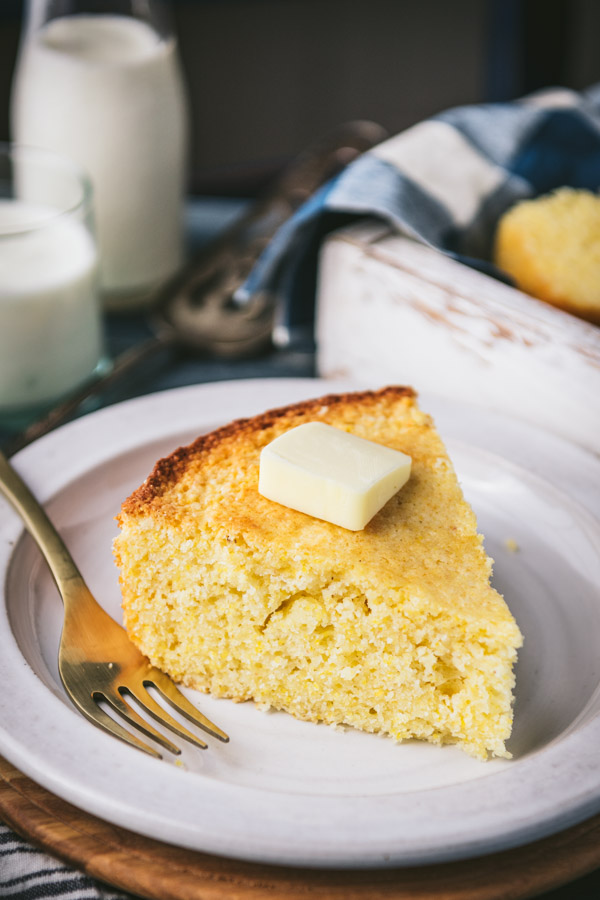
More Cornbread Recipes to Try
- Blueberry Corn Muffins
- Jiffy Cornbread with Creamed Corn
- Jiffy Cornbread Casserole
- Secret Ingredient Jiffy Cornbread
- Cornbread Dressing
- Sweet Cornbread Muffins
- Mexican Cornbread with Cheddar Cheese and Jalapenos
- Honey Cornbread
- Skillet Cornbread
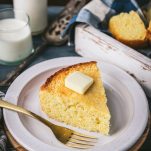
Sweet Cornbread
Ingredients
- 1 ½ cups all-purpose flour
- 1 cup fine cornmeal
- 1 cup sugar
- 1 tablespoon baking powder
- 1 teaspoon kosher salt
- 2 large eggs
- 1 ⅓ cups whole milk or well-shaken whole buttermilk
- ½ cup vegetable oil
- 1 tablespoon salted butter
Instructions
- Preheat oven to 325°F.
- In a large mixing bowl, whisk together the all-purpose flour, cornmeal, sugar, baking powder, and salt.
- In a separate bowl, whisk together the eggs, buttermilk or milk, and oil.
- Pour the egg mixture into the flour mixture; stir to combine.
- Place the butter in a very deep 10-inch cast iron skillet (at least 2 inches in depth), or in a very deep 9-inch square baking dish. If you don’t have a skillet or deep dish this size, you can use another similar 2-3 quart dish, such as an 11 x 7-inch pan. If using a smaller 8-inch square pan, don’t fill it to the top with all of the batter (or it might overflow in the oven). Bake the extra batter in muffin tins, if necessary.
- Put the skillet in the oven for about 3-5 minutes, until the butter melts. Use a pastry brush to coat the inside of the skillet with the melted butter.
- Transfer the batter to the buttered skillet.
- Bake for 40-45 minutes, until a toothpick inserted in the center comes out clean. Let cool for 15 minutes before cutting into squares or wedges and serving.
Notes
- Use a very deep 10-inch skillet (at least 2 inches in depth), or another 2-3 quart baking dish (such as a deep 9-inch square dish). The cornbread rises quite high (especially if you use buttermilk rather than regular milk), so it might overflow from a smaller dish. If you only have a smaller dish available, don’t fill the dish to the very top. Instead, save some of the extra batter and bake it in muffin tins.
- Use a finely-ground yellow cornmeal. Coarse cornmeal will give the bread a more grainy (rather than soft) texture.
- Use full-fat buttermilk or whole milk rather than a lower-fat alternative. The fat in the liquid adds richness to the batter and helps to keep the cornbread moist.
- Let the batter rest for 5-10 minutes before baking, if you have the time. This allows the baking powder to activate and incorporate more air.
- Don’t over-mix the batter or it will become too dense, and you’ll end up with dry cornbread.
- To check if the cornbread is done, insert a toothpick into the center and make sure it comes out clean. Don’t cook for too long, or it can dry out.
- As the name suggests, this is a very sweet cornbread that tastes almost like cake (similar to a box of Jiffy mix or Krusteaz mix). If you prefer your cornbread less sweet, reduce the sugar to to ¾ cup or ½ cup.
- Buttermilk gives the cornbread an even more moist and tender crumb; however, you can substitute with regular milk or cream if that’s what you have on hand.
- Optional add-ins: 1-2 chopped jalapeño peppers, 1 cup fresh blueberries, 1 cup shredded cheddar or Pepper Jack cheese, or orange zest and dried cranberries.
- Sweet Cornbread Muffins: Divide the batter between 11-12 paper-lined muffin cups. Bake in a 350°F oven for 18-20 minutes.
- Recipe adapted from The No-Fuss Family Cookbook by Ryan Scott.
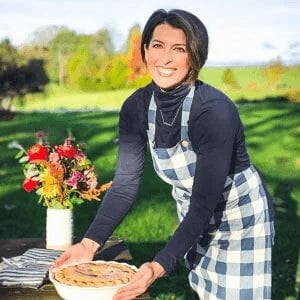
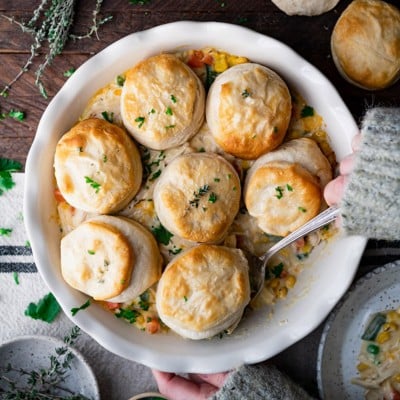
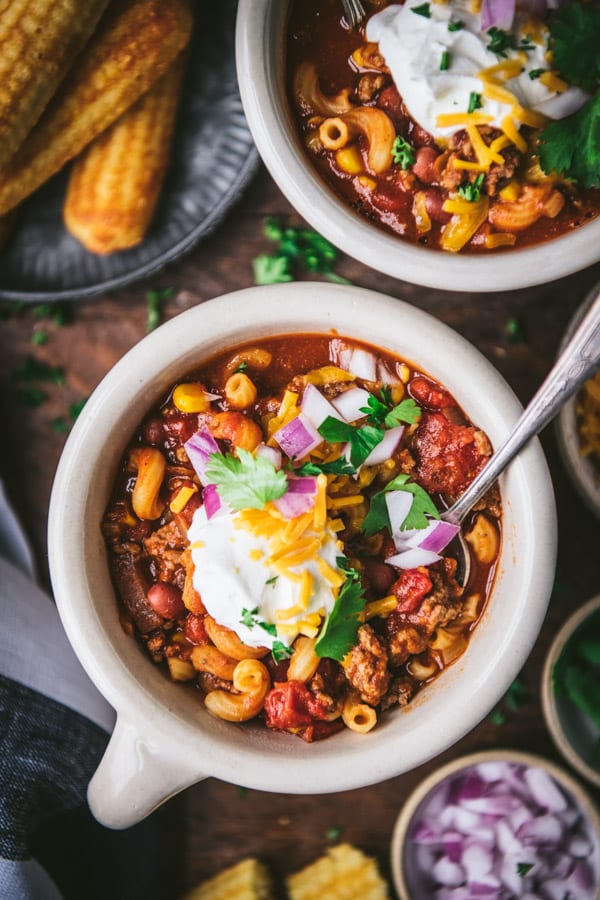
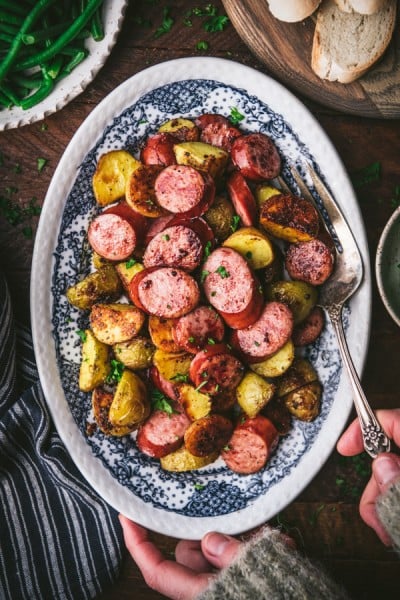








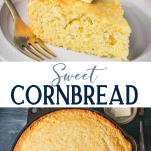
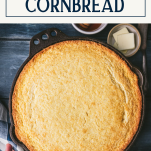

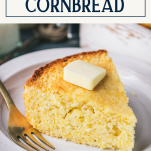
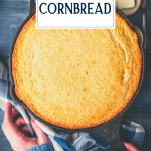
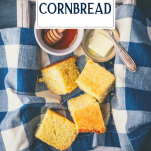
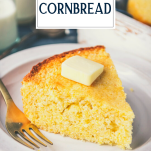
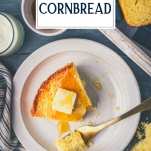
Ooh sweet indeed! But it looks yummy. It looks like a good item when I want to eat SOMETHING but I’m not hungry enough for a whole meal. Or when I want something sweet but don’t want a full blown sweet. I think when I make it I’ll start with between half and three quarters of a cup of sugar. Maybe then I can indulge in some honey butter, yum!
When I have a pan which I’m afraid may be too full, I put a cookie sheet on the rack underneath.
Funny story, Blair. I still remember the time when I used just one hand to try and put in a tray of muffins. Well, I DROPPED it. Batter ALL OVER the inside of the oven. A worse mess I’ve never seen. I always use both hands now.
Oh, no! There’s nothing worse than batter all over the oven. I guess we learn the hard way sometimes, right?! 🙂